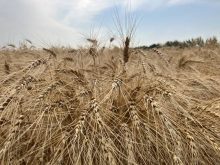SASKATOON — Flour prices fell in 2024, according to a new report from Statistics Canada.
The average retail price for a 2.5-kilogram bag of flour dropped 10.3 per cent compared with the previous year.
“One reason for the decline in flour prices is that millers paid lower prices for wheat,” said Statistics Canada.
Read Also

Farmland advisory committee created in Saskatchewan
The Saskatchewan government has created the Farm Land Ownership Advisory Committee to address farmer concerns and gain feedback about the issues.
Wheat prices fell in 2024 after being at elevated levels in 2022 and 2023.
The price of non-durum milling wheat in Saskatchewan was 22 per cent lower in 2024 than it was the previous year.
Canadian millers milled 3.3 million tonnes of wheat in 2024, down 0.8 per cent from 2023. They produced 2.5 million tonnes of flour, down 1.3 per cent.
An average of 87.9 per cent of Canada’s total wheat flour supply was consumed domestically between 2019 and 2023. It was sold in stores or used as an input in baking.
Canada exported 220,000 tonnes of wheat flour in 2024, with 92.8 per cent of that going to the United States and small amounts to the Bahamas and Cuba.
Millers in the United States milled 24.9 million tonnes of wheat in 2024, up 1.2 per cent from 2023. They produced 19.3 million tonnes of flour, also a 1.2 per cent increase.
Flour consumption is on the decline in the United States, according to a recent report from the U.S. Department of Agriculture’s Economic Research Service (ERS).
Per capita consumption was 128.9 pounds in 2024, the second smallest level since 1989, according to the ERS report. It was slightly better than the 2023 level of 128.2 lb.
Consumption is down 11.9 per cent since the start of the new century in 2000.
“Changing consumer preferences, led by the adoption of low-carbohydrate diets, reduced per capita wheat consumption,” said the ERS.
“Consumer interest in these diets spiked in the early 2000s, resulting in a decline in bread consumption and ultimately in per capita flour consumption.”
The interest in low-carbohydrate diets faded around 2005 but picked up again in 2008 along with rising consumer interest in gluten-free foods that still exists today.
MarketsFarm analyst Bruce Burnett agrees that slumping U.S. flour sales are the direct result of the Atkins and similar diets.
“I think that’s what we’re seeing,” he said.
He also agrees that “self-diagnosed” gluten intolerant people are having a big impact on consumption levels.
However, while the U.S. flour consumption numbers are disturbing for Western Canada’s spring wheat growers, it is not a total calamity.
“It would be a concern if that was our only market,” he said.
“But it isn’t.”
The U.S. purchased 839,700 tonnes of bulk wheat from Canada through the first eight months of the 2024-25 crop year, according to the Canadian Grain Commission.
That is a lot of wheat, but Indonesia, Japan, China and Peru all purchased more during that period.
Other parts of the world are experiencing a growth in consumption due to an expanding population that prefers wheat-based products.
Canada’s flour consumption has grew by 1.48 percent per year between 2018 and 2023, according to a report by ReportLinker Research.
It is expected to continue growing by 0.54 percent per year between 2024 and 2028.
Burnett believes immigration is the reason Canada is experiencing rising flour consumption. People from other parts of the world that consume a lot of flour are moving to Canada.
















